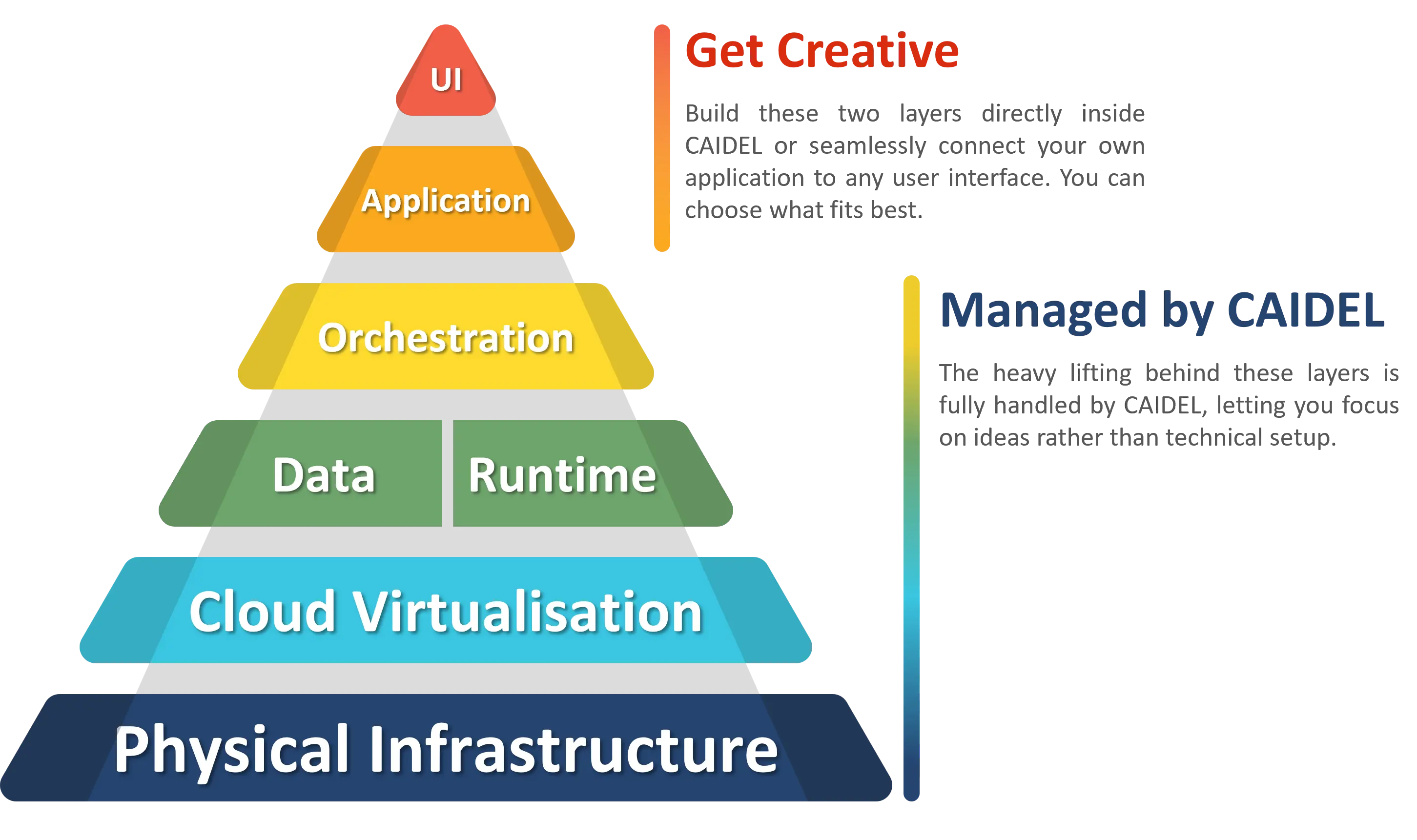
Understanding the AI Stack
From What You See to What Powers It
AI seems to be everywhere, in headlines, social media feeds, and the tools people use every day. It can feel like the world is moving fast, and you do not want to be left behind. Maybe you have an idea of your own: an app that understands your mood and suggests the perfect playlist, or an AI assistant that knows your movie taste better than your friends. The excitement is real, but so is the confusion about where to start.
That is where this guide comes in. It is made for curious minds who want to understand how AI applications are actually built, uncovering each layer. We will unpack the AI stack, the set of layers that that turn ideas into working applications, from what users see on the screen to the invisible processes running in the background.
This guide is for you — the curious creator who wants to understand how AI works, explained simply and with a touch of inspiration. Step by step, we’ll move from what you see on the surface to the powerful systems running behind it. By the end, AI won’t feel like a mystery, but a clear and accessible tool you can use to bring your ideas to life.
Before diving into the layers, let’s establish the core principle that animates every AI system:
This elegant equation captures the essence of artificial intelligence creation.
Data is the fuel of AI. Imagine a factory production line where raw parts enter at one end to produce something valuable. You can only create if you have enough high-quality raw materials. Here, data acts like those raw parts: it can be customer reviews, sensor readings, or large sets of images and text. Good data shows clear patterns and details, helping AI make smart decisions. Without it, AI has nothing to work with—just like a production line without materials.
Algorithms are the machines on the production line. They take the raw data and transform it into something useful. These are smart math tools that process the information. For example, neural networks mimic how the brain spots patterns, like identifying objects in photos. Reinforcement learning improves steps over time through trial and error, like teaching a robot to walk better. Algorithms learn from your data, getting sharper to create predictions, insights, or new solutions.
When data flows through algorithms—like parts moving along the production line—AI comes to life. It can do amazing things. For builders, the best part is accessibility: you can add your data, apply ready-made algorithms, and create AI without starting from zero, focusing on ideas rather than complex math.
This teamwork between data and algorithms works inside the AI stack—a system of seven layers that keeps everything running smoothly, like a well-organized factory. Let’s explore each layer, showing how they connect to turn your ideas into real AI tools.

Layer 1: User Interface – Your Gateway to AI Interaction
The user interface (UI) is where interactions happen, allowing users to give instructions and receive results. Imagine it as the elegant control panel of a luxury vehicle: sleek buttons, smooth responses, and an inviting design. You most likely have experienced this layer as chat windows, dashboards, or interactive forms.
A strong UI prioritizes usability, making it easy to input data and access outputs. For instance, a simple “Upload and Analyze” button can trigger complex processes behind the scenes. While visually appealing, its true power emerges when connected to the intelligence beneath it.
Layer 2: Application Layer – The Strategic Core
Flowing from the UI is the application layer, where system logic and workflows reside. Think of it as the smart navigation system in a vehicle: it interprets inputs, follows rules, selects the best path, and triggers the right processes.
Here, the data + algorithm equation springs into action. Your request data feeds into pre-trained models, generating tailored outputs. Visual tools often let builders create complex logic without deep coding, linking human intent to machine execution. This layer is where much of the AI’s unique value is crafted.
Layer 3: Orchestration & Deployment – Harmonizing Operations
Once the logic is in place, the orchestration and deployment layer acts as the conductor of the production line. It ensures machines and operators are synchronized, tasks are distributed efficiently, and the system scales smoothly from small trials to wide adoption.
This layer automates deployments and checks, keeping everything running reliably even when demands change. It bridges the creative upper layers and the supportive layers below, making sure AI flows seamlessly through the stack.
Layers 4 & 5: Parallel Pillars – Data Handling and Runtime Power
The stack now splits into two parts that work together as the engine room of our AI factory:
-
Layer 4: Data Layer – The Inventory Manager
The data layer acts like the inventory manager, storing raw materials and keeping them organized and accessible. Whether using databases for structured data or specialized repositories for complex queries, it ensures the right information is always available. This preparation allows the production line to run smoothly and supports effective decision-making. -
Layer 5: Runtime Engine – The Operators in Action
The runtime engine is where the operators—our algorithms—process the organized raw materials into useful outputs. Some tasks are quick, others intensive, but the operators adjust automatically to keep the line moving efficiently. Technically, this layer handles all computations, from lightweight tasks to large-scale model training, ensuring data transforms into insights reliably.
Together, these layers form the heart of the AI engine room, converting raw data into actionable intelligence while maintaining the system’s rhythm.
Layer 6: Virtualization – The Flexible Workshop
Virtualization is like having a magical factory space that can change shape on demand, much like Willy Wonka’s chocolate factory with its whimsical rooms that adapt and expand in surprising ways. Picture this: your production line is busy making chocolate bars, but suddenly you need to switch to crafting fizzy lifting drinks. Instead of rebuilding the whole factory, you just rearrange invisible walls to create separate areas—one for chocolates, one for drinks—all using the same floor, machines, and power. These areas can grow bigger if you get more orders, or shrink when things slow down, without stopping the work or wasting space.
From a technical perspective, virtualization separates computing, storage, and networking into flexible, shareable units. These units can be allocated dynamically, allowing multiple AI tasks to run safely in parallel, scale as needed, and optimize resources without disrupting operations.
Layer 7: Infrastructure – The Factory Floor
At the base lies infrastructure, the factory floor itself. This includes the physical machines, storage rooms, power systems, and networks that support the entire production line. Without a solid foundation, the line cannot operate effectively.
Technically, infrastructure provides the hardware for the AI stack: processors for calculations, memory for fast access, storage for data, and networks for moving information. Well-designed infrastructure ensures stability, reliability, and sufficient capacity, allowing the AI factory to operate continuously and at scale.
Empowering AI Innovators: How CAIDEL Simplifies the Journey
Building AI applications should feel like a creative process, not an engineering obstacle course. Whether you are designing an chatbot, a recommendation engine, or a custom predictive system, the challenge often lies not in the idea itself, but in connecting the many layers that make it real.
That is where CAIDEL comes in. It takes care of the complex part by managing Layers 3–7: orchestration, deployment, data handling, runtime, virtualization, and infrastructure. You stay focused on creativity while CAIDEL handles the rest.
You have complete freedom in how you build your AI in Layers 1-2. Create both the user interface and application logic directly inside CAIDEL, or design your interface elsewhere and connect it seamlessly to what you build on CAIDEL. Either way, it bridges your creative work with a robust, production-ready foundation.
By simplifying what happens behind the scenes, CAIDEL turns complexity into clarity, helping you move from idea to working AI in hours, not weeks. With CAIDEL, AI creation becomes an open door to innovation, not a technical hurdle.
-
1
Create
Tailor AI to your customers needs.
-
2
Connect
Deliver it straight to your customers.
-
3
Calibrate
Learn and improve continuously.